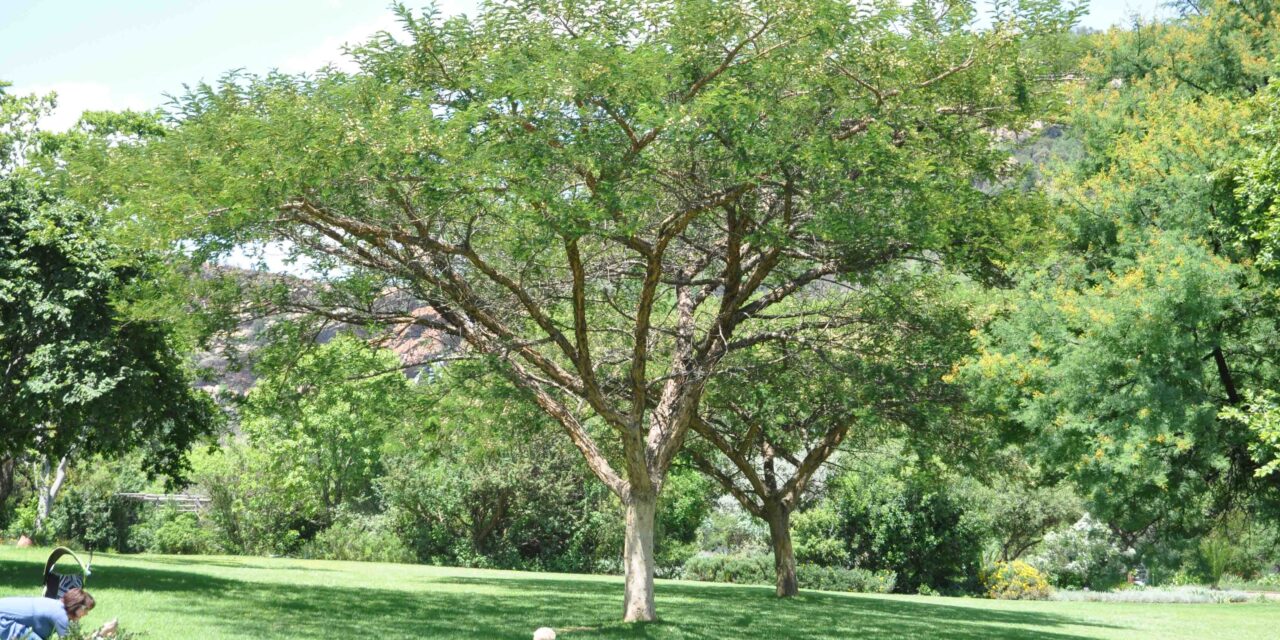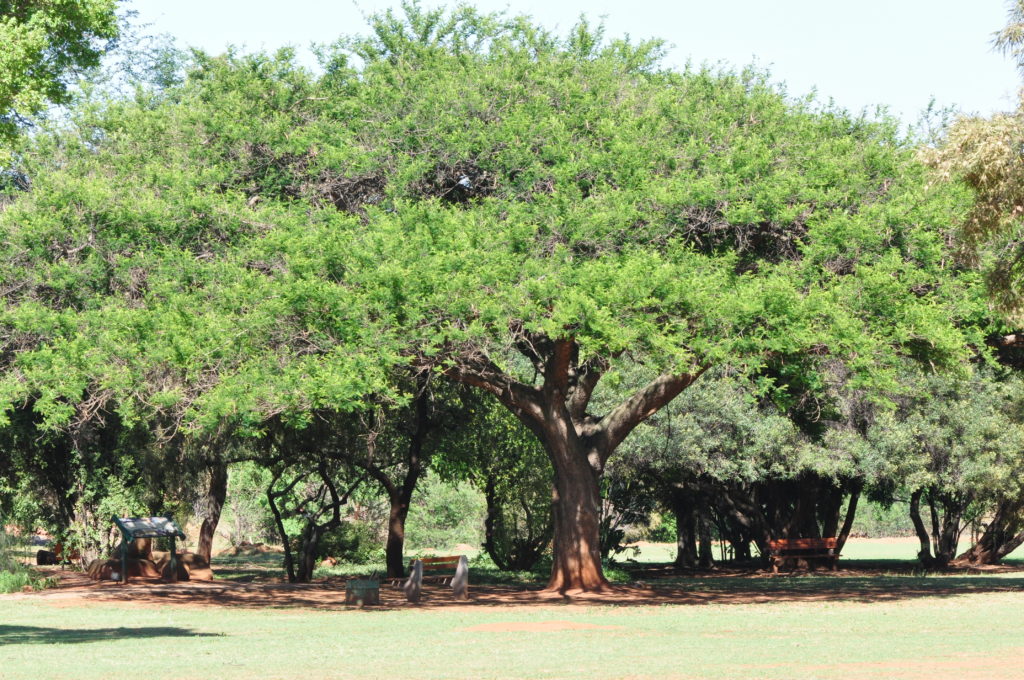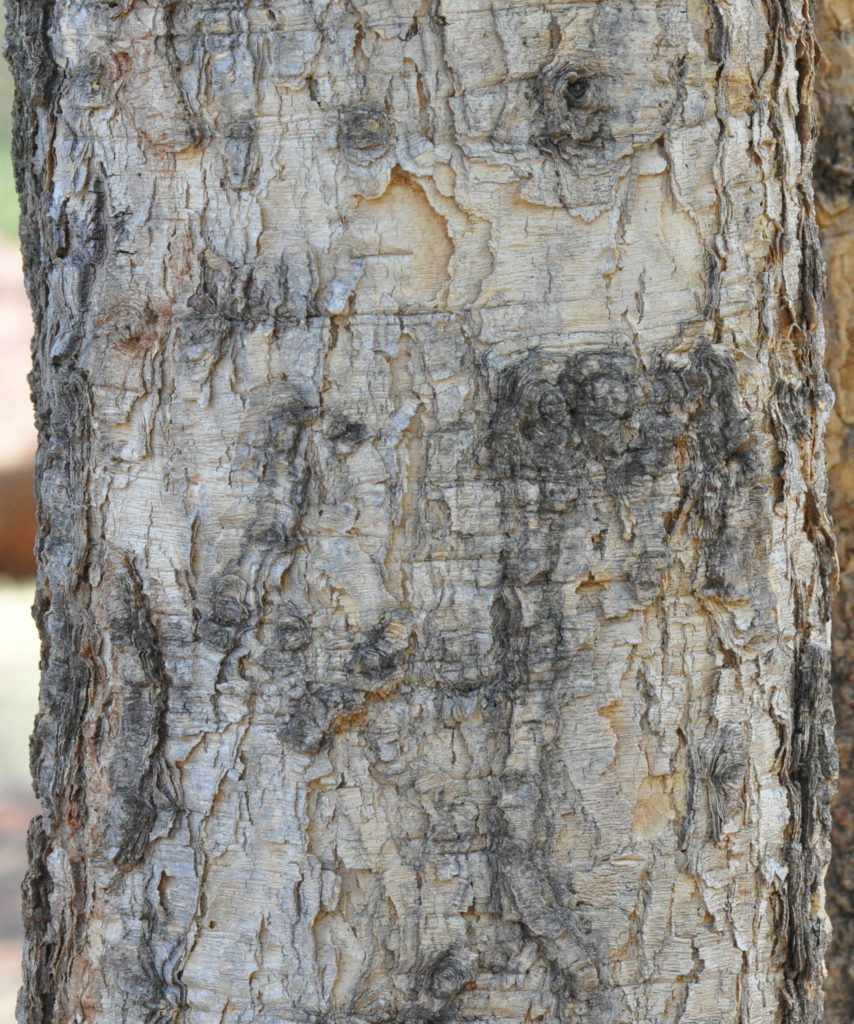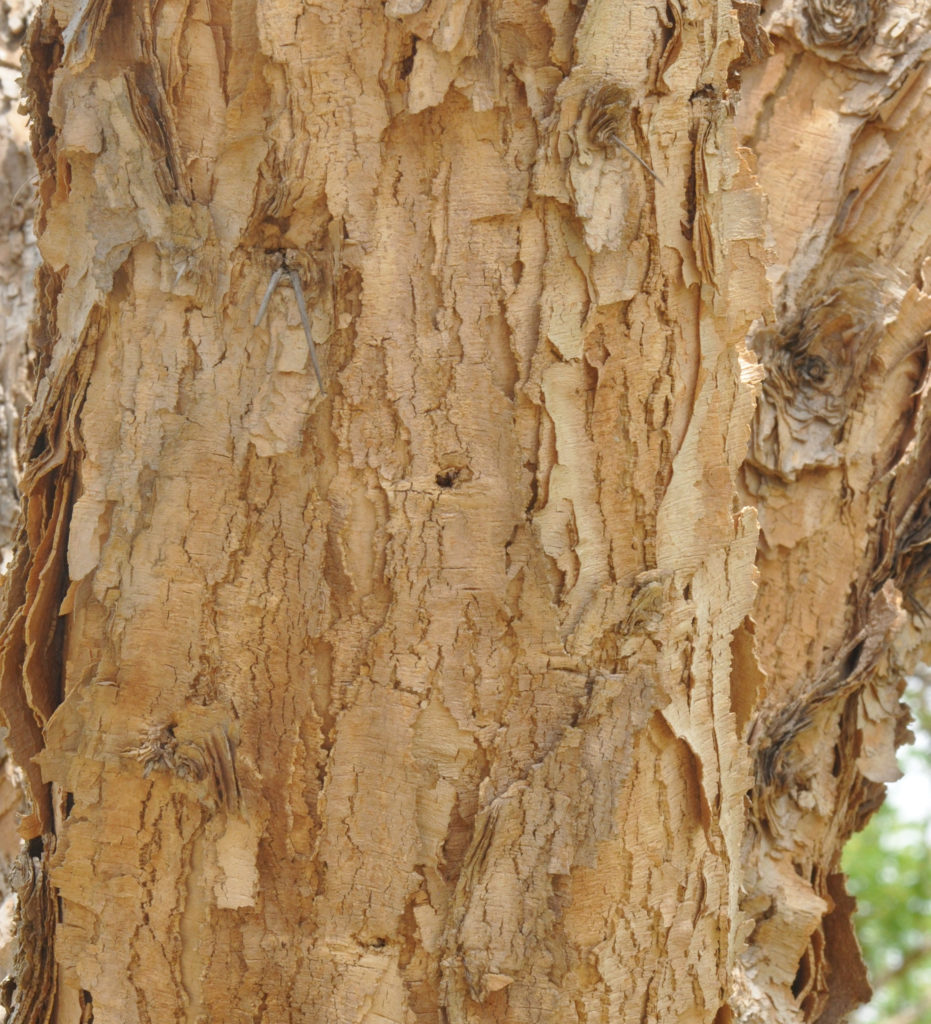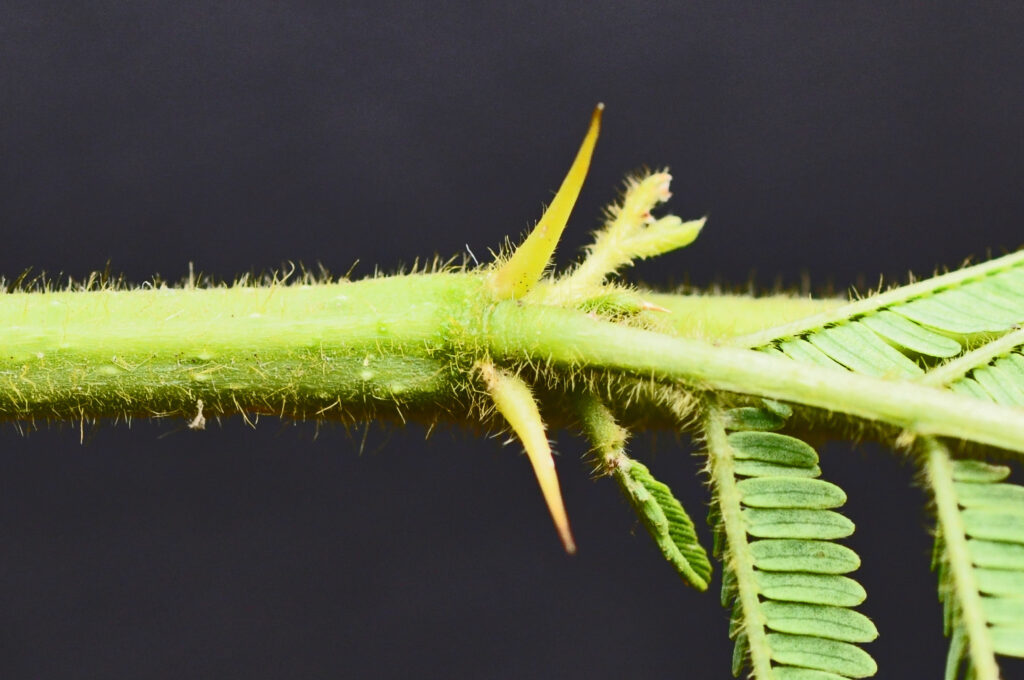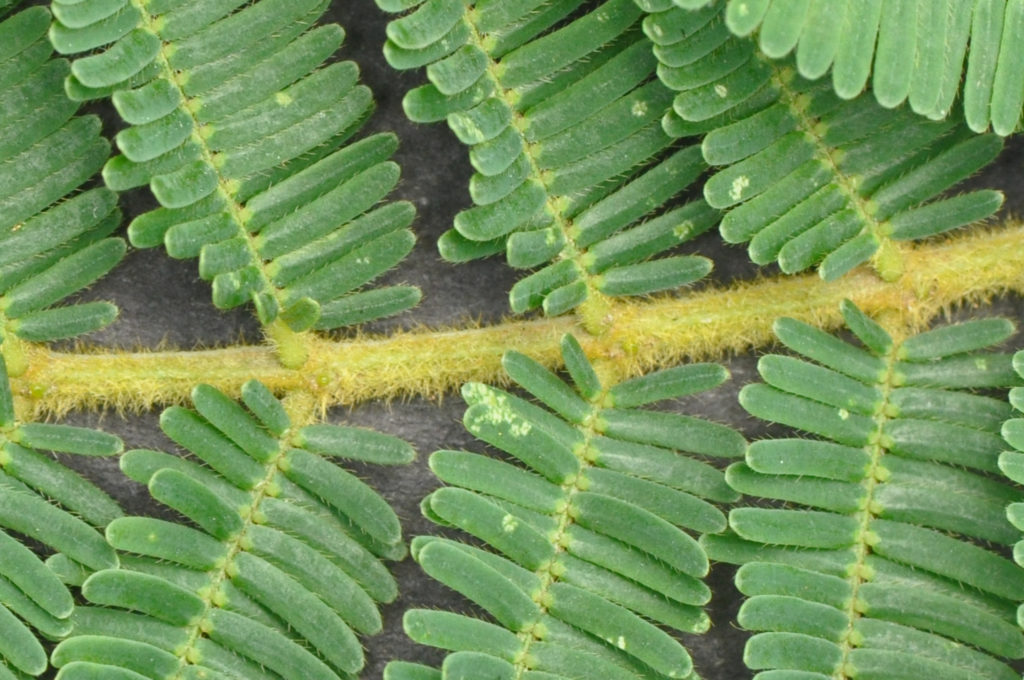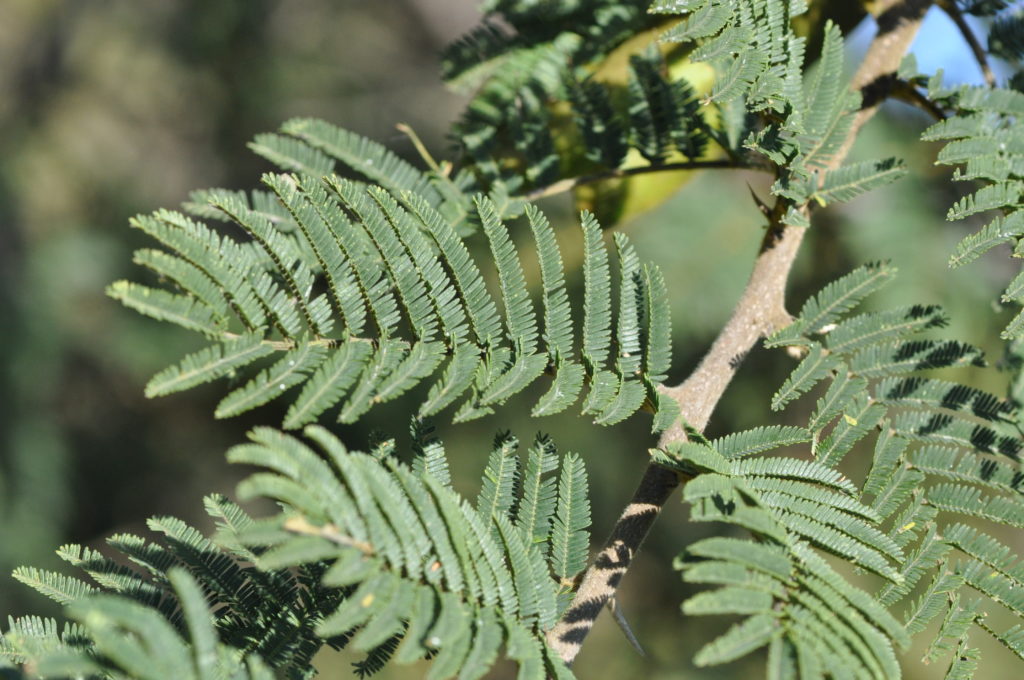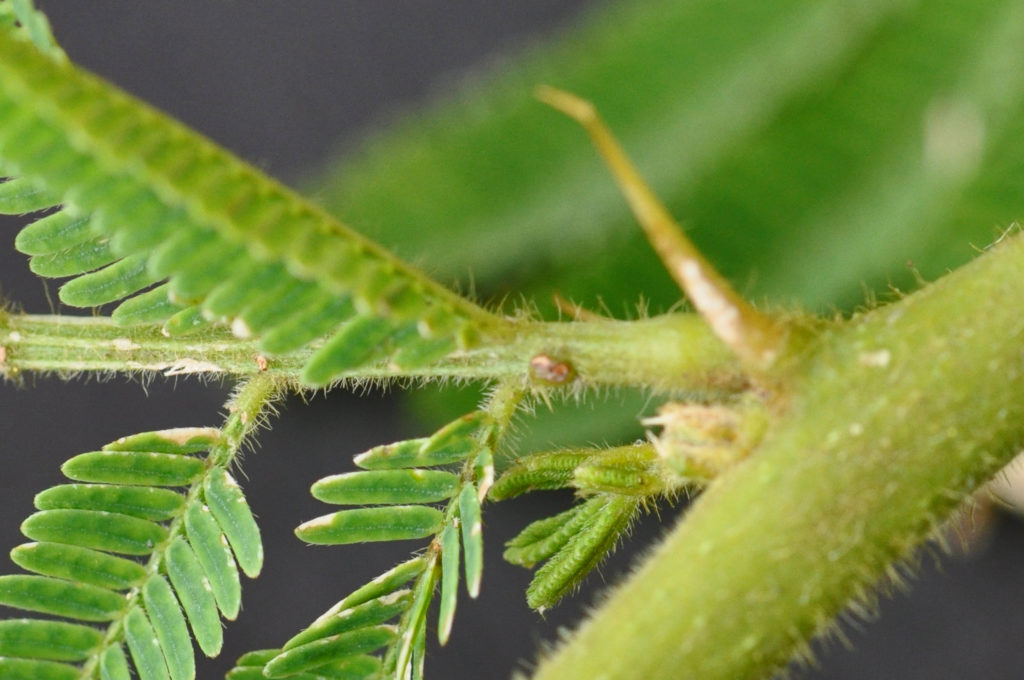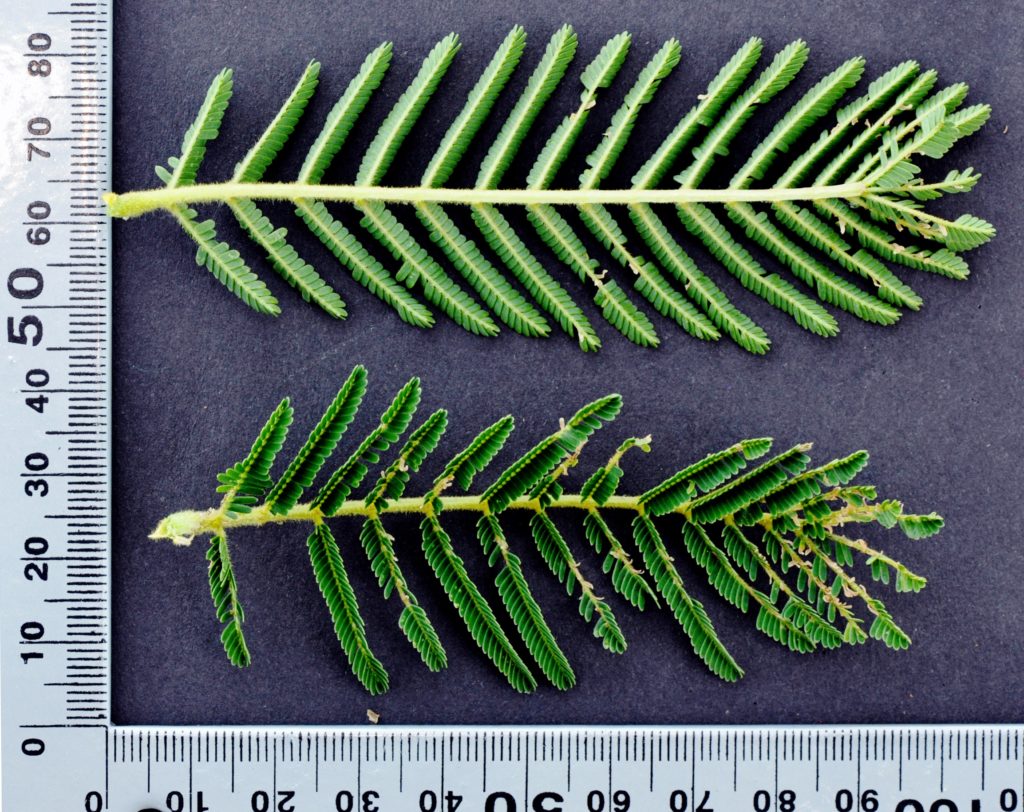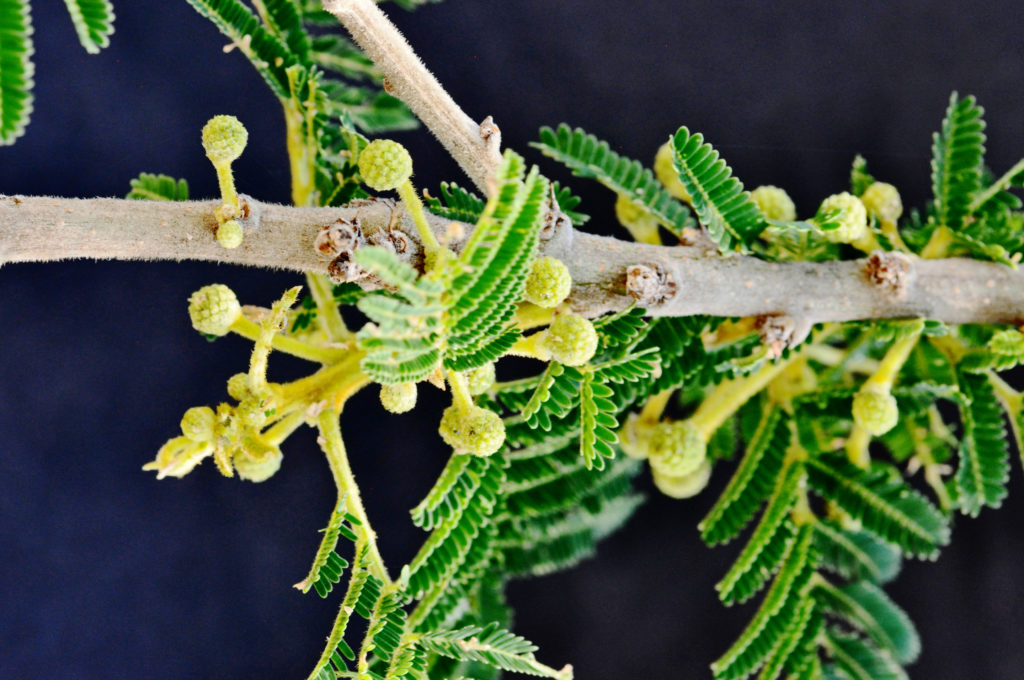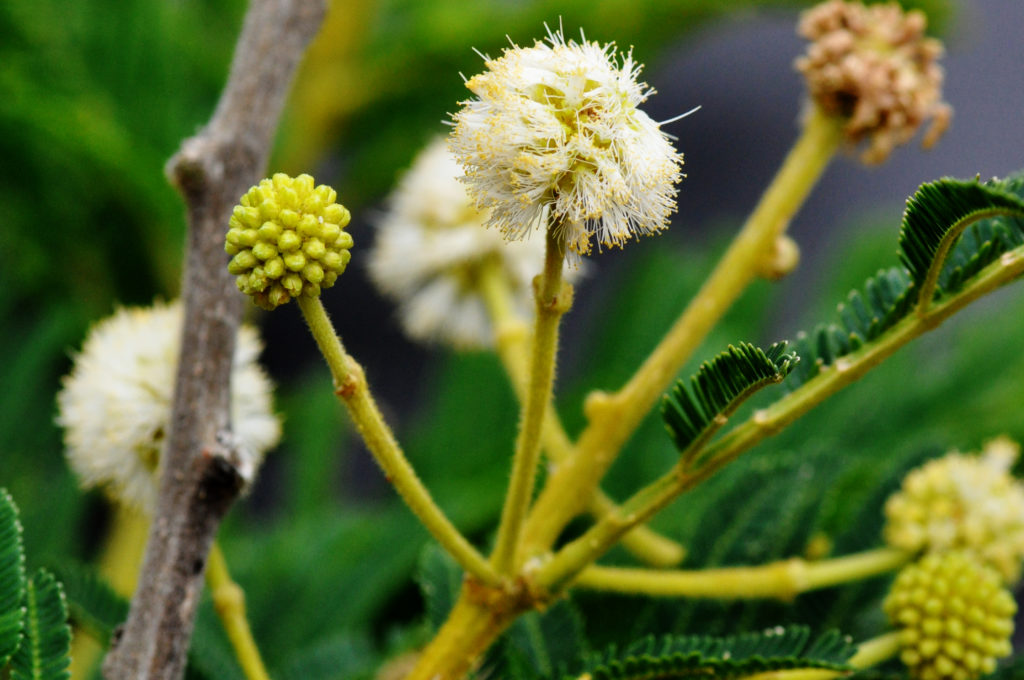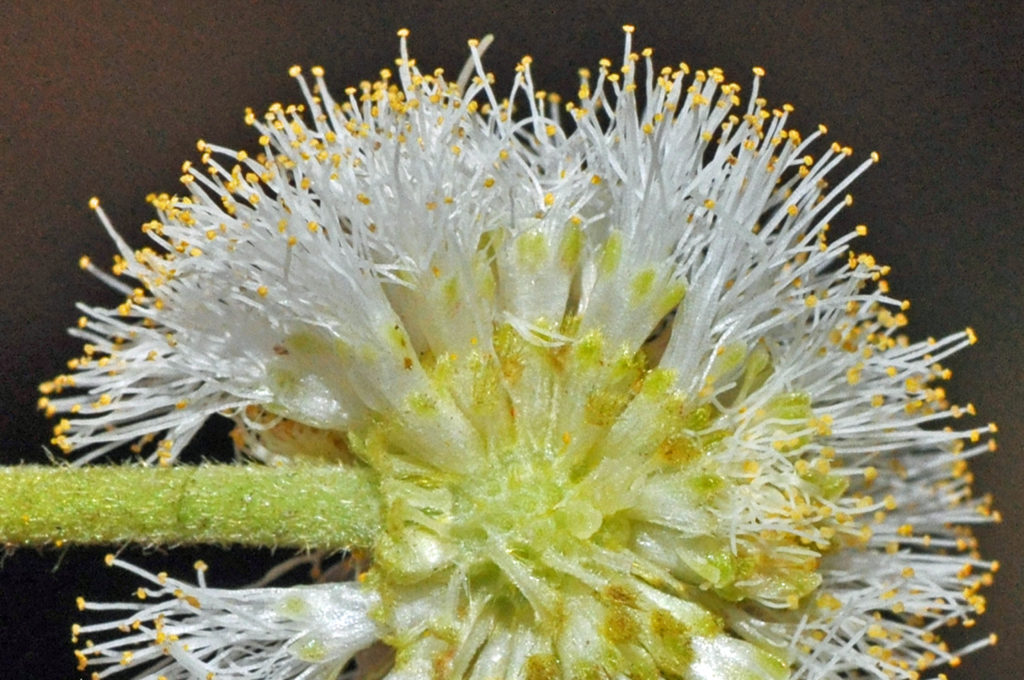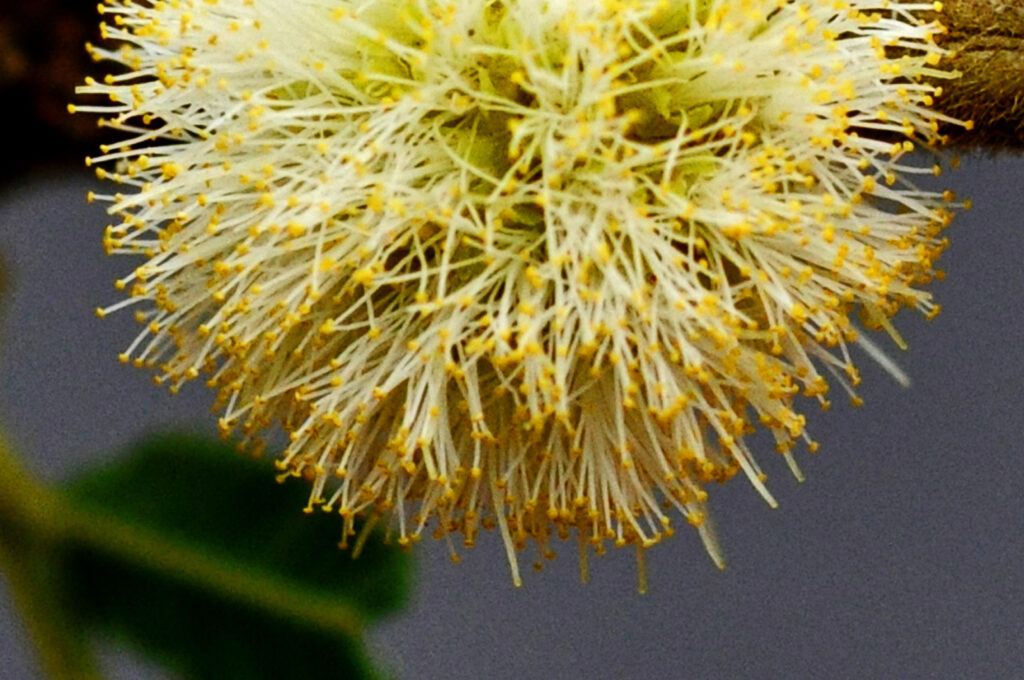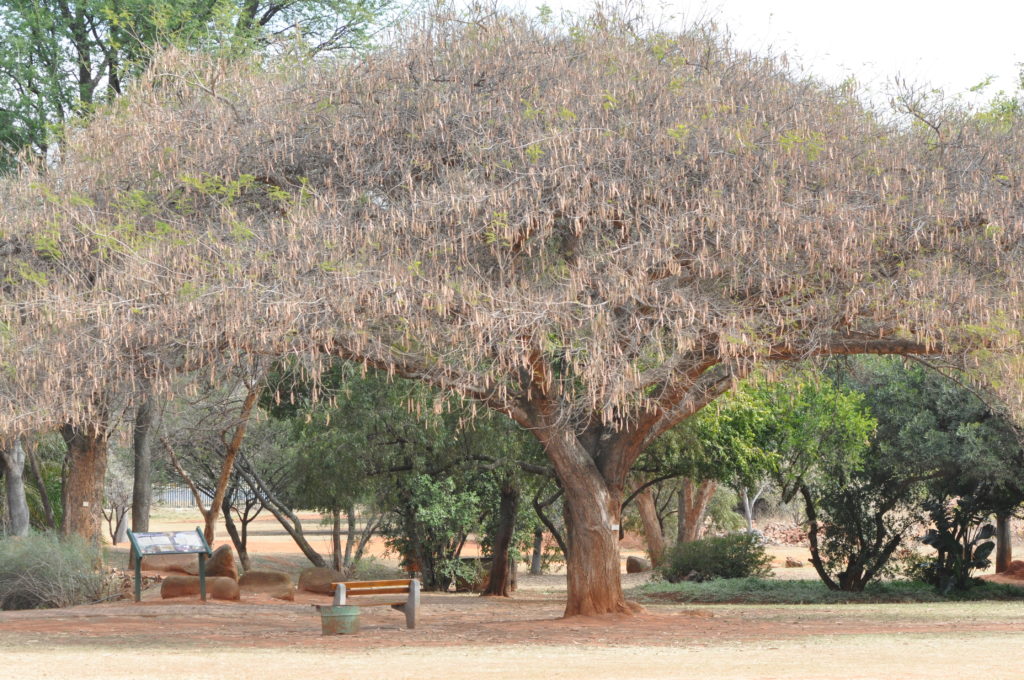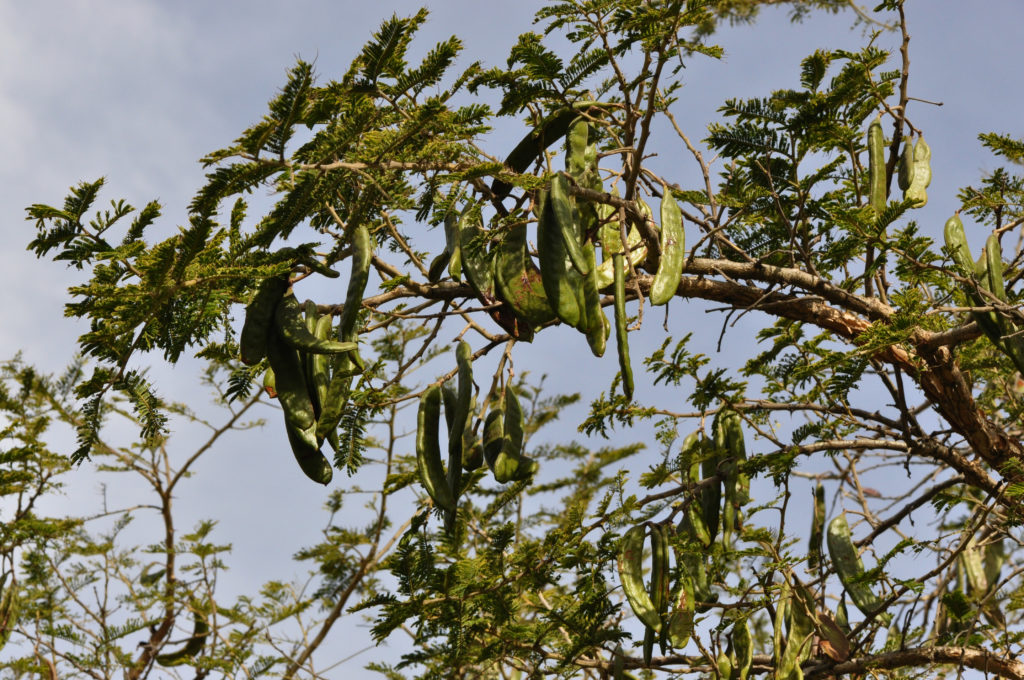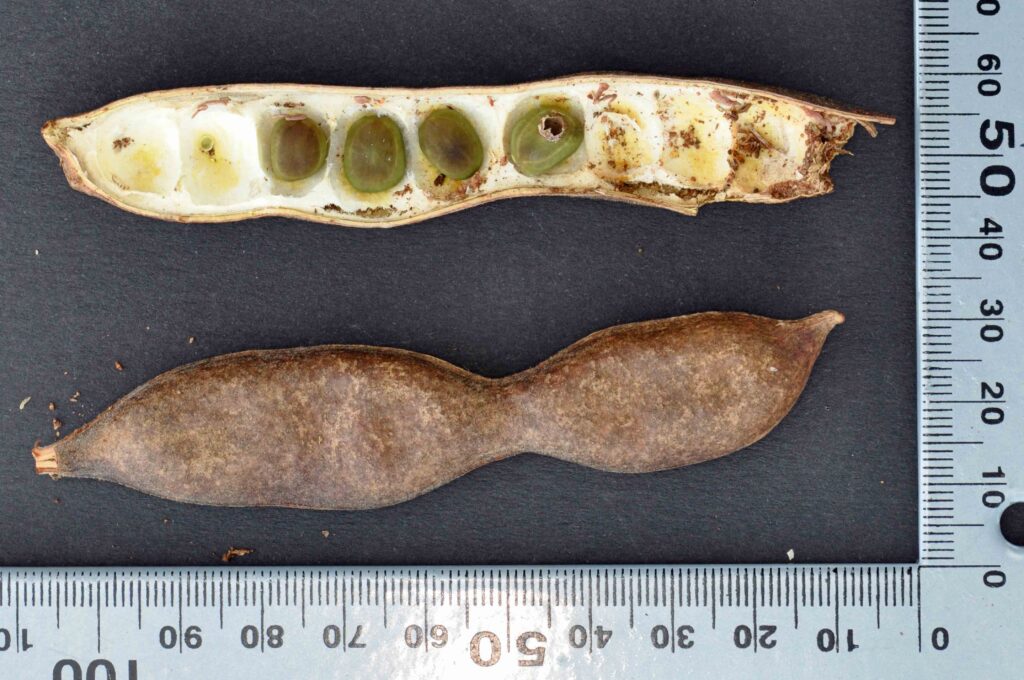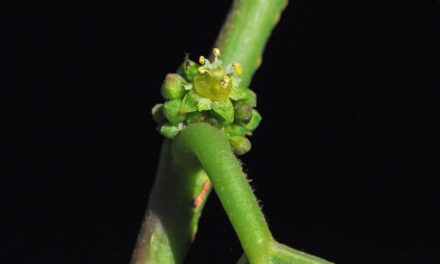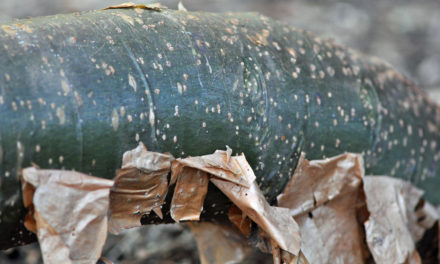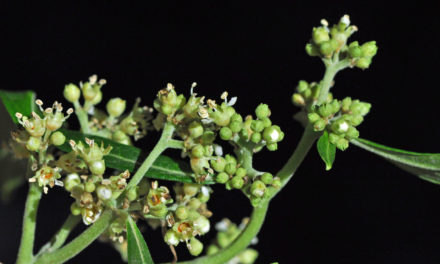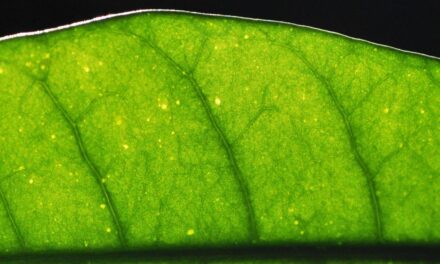General Info – summary
This deciduous, umbrella or flat-topped Tree is 7-18m high with corky/papery bark. Bipinnate Leaves have narrow, oblong, leaflets and straightish, paired & spinescent stipules. The many tiny, whitish, regular and bisexual Flowers are in condensed spikes – each with exerted colour generating stamens. The Fruit is a belatedly dehiscent, hard, woody pod up to 25cm long. The flattened seeds have U-shaped markings.
Description
Vachellia sieberiana var. woodii
Previous Names: Acacia amboensis, Acacia nefasia, Acacia sieberiana subsp. vermoesenii, Acacia sieberiana subsp. vermoesenii var. vermoesenii, Acacia sieberiana subsp. vermoesenii, Acacia sieberiana var. vermoesenii, Acacia sieberiana var. woodii, Acacia vermoesenii, Acacia woodii.
Common names: (Afr) Papierbasdoring, Platkroondoring, Platkroon-soetdoring, Verveldoring, Verveldoringakasia. (Eng) Flat-topped Thorn, Natal Camel Thorn, Paper-bark Thorn, Paperbark Thorn, Paper-barked Thorn, White Thorn, Wood’s Acacia. (isiZulu) Umkhamba, Umkhambathi. (Northern Sotho) Mooka, Mphoka, Mosibihla. (Setswana) Mokha, More-mosêtlha, More-ômosêtlha, Morumasela, Morumosêtlha. (siSwati) Sitfwetfwe, Umkhambane, Umnganduzi. (Tshivenda) Musaunga, Muunga-luselo. (Xitsonga) Umgandzi.
SA Tree No. 187.
Family: Fabaceae, or Leguminosae (Pea, bean or legume family). After the Orchidaceae and the Asteraceae, the Fabaceae is the third largest Angiosperm (flowering plants) family with 700+ genera and close to 20 000 species. Local Tree genera on this website include Acacia (Vauchellia, Senegalia), Albizia, Bauhinia, Bolusanthus, Burkea, Calpurnia, Colophospermum, Cordyla, Cyclopia, Dichrostachys, Erythrina, Erythrophleum, Faidherbia, Indigofera, Mundulea, Peltophorum, Philenoptera, Piliostigma, Schotia and Xanthocercis. The Fabaceae are recognisable by their fruit and their pinnately compound Leaves. Leaves may also be simple – even bilobed and usually have stipules – some of which may be spinescent. Leaflets are usually entire. Flowers are bisexual and bracteate. Regular flowers usually have 4-5 sepals and the same number of petals. Irregular flowers have 4-5 sepals and 5 or less petals. Stamens have anthers that have 2 pollen sacs and there are usually at least twice the number of stamens as petals – often 10. The superior Ovary has 1 locule containing 1 or more ovules. The Stigma and Style are simple. The single carpel develops into the Fruit, which is usually a pod. The mature pods may dehisce or break into segments. Seeds vary.
Name derivation. Species of the genus Vachellia and Senegalia were considered members of the genus Acacia until 2005. New Names. The genus Vachellia was named after George H. Vachell (1789 – 1839), chaplain and plant collector in China. Here the inflorescence is capitate (head like) and spinescent stipules are present. Plants in the genus Senegalia – (from Senegal) usually do not have spinescent stipules and the inflorescence is usually a spike. sieberiana: named after F W Sieber (1827-1915)– collector of plants and animals in Europe, middle East, Australia and South Africa. A number of species were named after him. woodii was named after a Natal farmer, trader and botanist: John Medley Wood (1827-1915). He was the curator of Durban Botanical Gardens from 1882 – 1913 and founder of the National Herbarium.
Conservation: National Status: L C. (Least Concern). Assessment: 2005 (W. Foden and L. Potter).
Tree
This is one of the most striking of our indigenous trees. The single stemmed Tree is usually umbrella shaped or flat-toped and up to 18m high – usually much less. It has a spread, which is often greater than its height (photos 64 & intro photo). The young tree grows up to 1,5m high per year. Trunk has a diameter of up to 0,8m. The corky Bark may be papery – especially on the branches. It is light brown to greyish yellow (photo 599), sometimes flaking in strips (photo 302) – mainly on the branches and this may expose a yellowish underbark. The Bark is flammable, and the passage of fire may blacken the bark, but the tree usually survives. Young hairy Branches (photo 32 – under Leaves) are yellowish or greyish (photo 664 – under Leaves) and thicken as they grow.
- 64 2016/10/25 Pretoria NBG. Photo: David Becking.
- 599M 2014/10/30 Pretoria NBG. Photo: David Becking.
- 302 2014/10/07 Walter Sisulu NBG. Photo: David Becking.
Leaves
On this deciduous tree (photo 610 under Fruit), the dark green Leaves may be hairy (photos 31 & 32). They are bipinnate (compound: twice-pinnate leaves. The rachis – central axis, has lateral pinnae “branches” not leaflets and the pinnules “leaflets” are on these “side branches” – photo 664). The leaves may have 8 to 30 pairs of pinnae, each bearing from 12 to 45 pairs of Leaflets. Each leaflet is narrowly oblong, usually up to 3 x 1mm and hairy above, and on margins (photo 707). They are usually hairless below. There is almost no space between leaflets (photo 707). The Rachis (main axis bearing flowers or leaflets) is hairy (photo 31). The hairy Petiole (leaf stalk) is short, up to 1cm long and may be swollen (photo 31). Collectively the rachis and petiole (leaf length) may reach 13cm but is usually shorter. The Petiolule (leaflet stalk) is very short (photo 32). A small knob-like gland (photo 31) is present on the upper surface of the petiole – just below the lowermost leaflets (photo 31). Glands are also present at the base of the upper pinnae pairs. The Stipules (basal appendage of the petiole) are spinescent (having or becoming spiny). These paired Spines lack swellings and are greyish white, straight or almost so and either short (photo 32) or up to 9cm long. Spines are less common or absent in older trees.
- 32 2014/11/29 Linden. Photo: David Becking.
- 707. 14.11.2018. Walter Sisulu NBG. Photo: David Becking.
- 664 2014/04/21 Walter Sisulu NBG. Photo: David Becking.
- 31 2014/11/29 Linden. Photo: David Becking.
- 600 2014/10/30 Pretoria NBG. Photo: David Becking.
Flowers
These scented Flowers occur in condensed inflorescences (a group or cluster of flowers) called Spikes (simple indeterminate inflorescence with sessile flowers on a single unbranched stalk). Each spike is supported by a slender relatively long Peduncle (the stalk holding each whole inflorescence). Each peduncle contains a ring of bracts (photo 761). The spikes are clustered in leaf axils or are solitary. Each spike is up to 2cm wide and may appear as a white, pale to yellow or a creamy sphere. Flowers are usually bisexual and actinomorphic (Regular, symmetrical. Flowers are vertically divisible into similar halves by more than 1 plane passing through the axis). The numerous flower buds occurring in a single inflorescence are visible (photo 761). Each Perianth (the 2 floral envelopes considered together; a collective term for the calyx and corolla – photo 143) has a Calyx that is up to 3mm long with protruding light green lobes. The Corolla also has light green lobes and is up to 4,5mm long (photo 143). The yellow Anthers combine with the white Filaments forming a mass of exerted stamens and generating the overall spike colour. Within the stamens is a single Pistil (a unit of the Gynoecium, the female element of the flower, composed of the Ovary, Style and Stigma). Here the superior Ovary (one that is free from the calyx or perianth) contains a single locule (cavity within an organ). A single Stigma and Style are present. In photo 143, the styles are yet to protrude and are not visible. Here the stamens are still in the pollen releasing stage. After the anthers have shed their pollen, the white styles protrude past the anthers (photo 769). Here the now receptive stigmas, receive pollen from different flowers of the same species and so help to ensure cross-pollination. Insects (including bees, wasps, beetles, thrips and butterflies) are the main pollinating agents. (Sep-Dec).
- 615 2014/10/30 Pretoria NBG. Photo: David Becking.
- 761 2014/11/27 Linden. Photo: David Becking.
- 143 2016/10/25 Pretoria NBG. Photo: David Becking. Dissected.
- 769 2014/11/27 Linden. Photo: David Becking.
Fruit
Prior to the spring flush of new laves, a massive number of yellow to brown pods may still be present (photo 610). The stout, usually creamy brown, thickened, possibly hairy, woody and pendulous (photo 14) Fruit is a belatedly dehiscent Pod that may only open after falling. It is hard, woody, straight or slightly curved and up to (5-20 x 1,3-3,5) cm. Parasitic holes may be visible. The flattened Seeds have a u-shaped marking and are often tiny parasite generated holes in the seed are visible 602). (Mar-Aug).
- 610 2016/08/23 Pretoria NBG. Photo: David Becking.
- 14 2018/09/15 Kirstenbosch NBG. Photo: David Becking.
- 602 2014/10/30 Pretoria NBG. Photo: David Becking.
Distribution & Ecology
Vachellia sieberiana var. woodii is widespread and var. woodii is the only one present in South Africa. This fast growing, fairly hardy Trees are located in open bushveld. They may be the only tree in woodland and wooded grassland. They often occur below the escarpment usually up to an altitude of 1 600m. They occur in floodplains, alongside rivers and in deep soils. The Bark “shelters” invertebrates that are sought after by Birds. Thrips (minute, slender insects with fringed wings) puncture and suck sap out of the cells. Insects seeking nourishment, including nectar, also attract birds. The tree is a nesting place for barbets. The bark is inflammable but can survive a fire better than many trees. Rainwater may collect in the bark and this may make the tree more susceptible to lightning strikes. There are excellent specimens near Estcourt, Ladysmith and Colenso. Trees are naturally located from KwaZulu-Natal, Gauteng – Walter Sisulu NBG and Pretoria NBG, Limpopo, Mpumalanga. Beyond South Africa, they occur in Swaziland, Botswana, Northern Namibia and northwards to tropical Africa – as far as Sudan and Ethiopia. The local tree has a symbiotic relationship with a Rhizobium bacterium through which the tree and surrounding plants eventually benefit from the fixing of atmospheric Nitrogen. Game eat fallen Pods. Grey louries (touraco) (Corythaixoides concolor) eat the pods. A different variety of Vachellia sieberiana species (var. sieberiana) occurs beyond our borders in northern Mozambique.
Ethnobotany
This very attractive and quick growing tree is moderately frost-tolerant. The inner Bark is a source of fibre and used for bead stringing and dyeing. Local medicine makes use of the bark. Young pods and leaves may contain prussic acid (hydrocyanic acid HCN). Prussic acid can be fatal to livestock when eaten in large quantities over a short time span. Higher concentrations are contained in wilted leaves. Cattle consume fallen pods but they may give milk an unpleasant taste. The tree produces an edible Gum (a water-soluble sugary polysaccharide that is exuded to seal wounds and prevent infection by bacteria and fungi). It also helps to prevent trees from freezing. The gum is used as an adhesive and for making marking ink. The Wood is prone to borer attack and not much used, unless it is seasoned in water for 4+months. It is prone to termite and beetle (Order Coleoptera) attacks but with seasoning, the wood has a stronger finish. The density of wood is close to 650kg per cubic metre. It will thus float in fresh water. Holes are used as nesting sites by Pied Barbets (fairly shy and solitary birds that occurs throughout Southern Africa) and the Crested Barbets (with its bizarre colouring is more visible, less wary and occurs in central and northern South Africa). The Leaden Hairtail (Anthene amarah amarah) butterflies are on the wing year-round. Their larvae feed on the leaves of many species of Vachellia including this one, and on Senegalia ataxacantha.
References
Boon, R. 2010. Pooley’s Trees of eastern South Africa. Flora and Fauna Publications Trust, Durban.
Burrows, J.E., Burrows, S.M., Lotter, M.C. & Schmidt, E. Trees and Shrubs Mozambique. Publishing Print Matters (Pty) Ltd. Noordhoek, Cape Town.
Coates Palgrave, M. 2002. Keith Coates Palgrave Trees of Southern Africa, edn 3. Struik, Cape Town.
Foden, W. & Potter, L. 2005. Vachellia sieberiana (DC.) Kyal. & Boatwr. var. woodii (Burtt Davy) Kyal. & Boatwr. National Assessment: Red List of South African Plants version . Accessed on 2024/03/12.
Lawrence, G. H. M, 1951. Taxonomy of Vascular Plants, The Macmillan Company, New York. Tenth Printing 1965.
Ross, J. H. A conspectus of the African Acacia Species. 1979. Botanical Research Institute.
Palmer, E. & Pitman, N. 1972. Trees of southern Africa, Balkema, Amsterdam, Cape Town.
Schmidt, S. Lotter, M. & McCleland, W. 2002. Trees and Shrubs of Mpumalanga and the Kruger National Park.
van Wyk, B. & van Wyk, P. 1997 Field guide to Trees of Southern Africa, Struik, Cape Town.
http://www.plantbook.co.za/vachellia-sieberiana-var-woodii/
https://en.wikipedia.org/wiki/Acacia_sieberiana
http://kumbulanursery.co.za/plants/vachellia-siberiana-woodii-
http://www.sntc.org.sz/flora/speciesinfo.asp?spid=1196
http://www.zimbabweflora.co.zw/speciesdata/genus.php?genus_id=667
http://waynesword.palomar.edu/plaug99.htm

